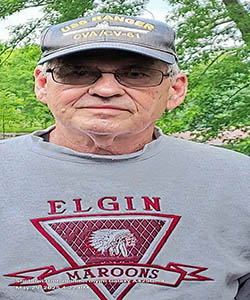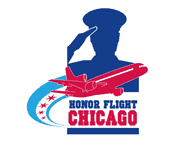Navy Vietnam War Chana, IL Flight date: 06/18/25
By Mark Splitstone, Honor Flight Chicago Veteran Interview Volunteer
David Stevens was born in Elgin, Illinois in 1950. When he was a boy he saw the film “The Fighting Sullivans,” about five brothers who died when their cruiser was sunk during World War II, and he knew what he wanted to do with his life—join the Navy. In hindsight, he realizes that a movie is perhaps “a silly reason” to make a potentially life-altering decision, but once he decided, he stuck to it. In fact, in his high school yearbook he wrote that joining the Navy was his goal after high school. As the Vietnam War heated up during his high school years he saw another reason for this decision–he wanted to volunteer to do what he wanted to do and avoid the risk of being drafted and potentially doing something that he didn’t want to do.
Dave graduated high school in 1968, near the peak of America’s involvement in Vietnam. He enlisted as part of the buddy system with a good friend, and the two of them went to boot camp at Great Lakes in April 1969. Contrary to most people’s opinion of boot camp, Dave says he liked it and thought it was “fun.” He had been the MVP of his high school track team and had run the high hurdles at the state championship, so he was an excellent athlete and was in good shape. These factors made boot camp easier for him than for most of the other recruits.
After boot camp, Dave was assigned to Lakehurst, New Jersey, to train to become an aviation boatswain’s mate (AB). At this time, his older brother was a Marine who worked on planes as a structural mechanic, and Dave thought following in his footsteps and learning about planes would be interesting. But even though ABs have “aviation” in their title, they don’t actually work on planes. Instead, they’re responsible for the launch and recovery of aircraft on ships and at naval air stations. In Dave’s case, his specialty would be the catapults that are used to launch planes from aircraft carriers. While initially disappointed to not have the opportunity to work on the planes themselves, he quickly realized that the duties of the ABs are some of the most critical on a carrier. The responsibilities of the ABs can mean the difference between life and death for the aircrews, and their roles are so closely intertwined with these crews that they’re categorized as airmen rather than seamen.
After twelve weeks of AB school, Dave had a thirty-day leave in Elgin and then headed to Alameda, California, for his first cruise aboard the USS Ranger. His initial thought on seeing the Ranger was that it was huge and “overwhelming.” There were nearly 4,000 sailors aboard, and the ship could carry up to 100 aircraft. As a Midwesterner, he had never seen anything like it, and for a while he admits that he was lost on it.
Up to that point, all of Dave’s training had been on land, so as the ship sailed from California to Vietnam, he and the rest of the crew spent most of their time learning how their tasks were performed in real life. After a plane was lined up to be launched, an AB would go below the nose and attach the plane to a shuttle, which in turn was connected to a piston driven by high-pressure steam. After attaching the shuttle, the AB would clear out and signal to the flight officer that the plane was ready to be launched. The flight officer would then look to the pilot, and once the pilot signaled that all his controls were in order, the flight officer would launch the plane. The catapult would force the plane to accelerate to 120 miles per hour in the span of two seconds over the course of 100 yards. After all the planes were launched, the airmen would immediately begin preparing the flight deck for the incoming squadron from the prior flight, which was usually only a short distance away by then. After those planes were returned, the process was once again reversed, as the airmen prepared to launch the next wave.

Every thirty days, the ship would come into port, usually in the Philippines or Japan, for repairs and resupplying operations, as well as R&R for the sailors and airmen. After Dave’s first cruise, the Ranger returned to Alameda, spent several months there, and then headed back to Vietnam. During his second cruise, from 1970-1971, there had been quite a bit of turnover in the crew and Dave’s responsibilities were greatly expanded. During his first cruise, Dave was mostly below decks learning how everything was done during launches since that’s where most of the machinery was located. On his second cruise, though, he was on the flight deck and acted as the topside catapult supervisor. He was also teaching the new crews what to do and how to launch, just as the more-experienced airmen had done for him on his first cruise. The pilots had a lot of respect for these men, and in fact they would sometimes take Dave’s movie camera up with them and film bombing runs over North Vietnam.
Planes were often damaged and sometimes lost. The Ranger lost about three planes on each of Dave’s cruises, due to being shot down or crashing. He recalls one tragic episode when a lieutenant commander apparently had a heart attack while taking off, resulting in his plane immediately crashing into the ocean. The co-pilot was able to safely eject, but the pilot was never found. The danger wasn’t isolated to the pilots either. Dave recalls a man on the flight deck being sucked into the intake of an A7. There was also always a risk that someone on the flight deck could get blown off the ship as jets were rotated. When you’re nineteen years old, Dave says, you feel that you can’t get hurt, but on an active flight deck Dave came to realize that you most certainly can. Danger was all around and he had to constantly be aware of his surroundings.
Dave does have some pleasant memories from his days on the Ranger that have stuck with him through the years. First, he saw Bob Hope perform his annual Christmas show, which was broadcast back to the U.S. His parents told him that they watched it on TV and were hoping to catch a glimpse of him, but unfortunately weren’t able to. Second, Dave was chosen to be on the Ranger’s softball team, which would conduct their practices in the ship’s hangar. One time, they went to the Philippines to compete against some other teams and ended up winning the tournament. The highlight for Dave, though, was that he was able to both take off and land on the carrier, which, despite facilitating countless takeoffs and landings, were things he never thought he’d get to do.
When Dave returned to Alameda from his second cruise in 1971, one of the first things he did was marry his high school sweetheart, Linda. The two of them lived together in Alameda, and then Dave was transferred to Naval Air Station Whidbey Island near Seattle. At Whidbey they had their first child, and then in 1973 Dave completed his Navy commitment. Dave, Linda, and their young son returned to Elgin, and Dave says that the community was supportive of his service and appreciative of what he had done. He almost immediately got a job working in a General Mills manufacturing facility in West Chicago, and he and Linda went on to have two more children.
Dave ended up working at the General Mills facility for 35 years, retiring as a department manager in 2008. He and Linda have now been married for 54 years, and in addition to their three children, they have five grandchildren. In retirement, Dave likes to travel, fish, hunt, and garden, and for a while he even farmed and sold daylilies. He and Linda live in a house on a lake in Chana, IL, twenty miles south of Rockford.
Dave generally has positive memories of his years in the service, and as he’s gotten older, he says he has a greater appreciation for that period in his life. However, he is still haunted by events such as the lieutenant commander dying on takeoff, and he plans to look for that man’s name when he goes on his Honor Flight. He enjoys attending Ranger reunions and is especially gratified when the men who he instructed on his second cruise approach him to express how much they learned from him, not just about launching planes but about life. Dave says it feels nice to be remembered after all these years.
Dave loves to watch the Top Gun films, and in fact some of the scenes from the first movie were filmed on the Ranger. He says everyone in his house knows when he’s watching them because he turns the volume way up. Even after watching the films so many times, whenever he sees the jets take off, he recalls the thrills of his days on the Ranger and gets goose bumps. The next time you watch Top Gun and see the ABs scrambling around the flight deck before sending the jets on their way, think about Dave and his service to our country.


